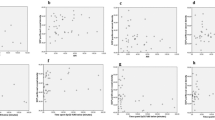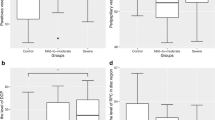Abstract
Aims
To compare optic disc perfusion, radial peripapillary capillaries (RPC) and macular vascular density, between normal subjects and subjects with obstructive sleep apnea syndrome (OSAS) using spectral-domain OCT angiography (OCTA).
Methods
Sixteen eyes of patients with mild OSAS, 17 eyes with moderate OSAS, 20 eyes with severe OSAS on polygraphy and 28 controls were evaluated with OCTA RT XR Avanti (AngioVue software, Optovue Inc., Fremont, CA). Optic nerve head (ONH), RPC and macular vessel density were measured. Clinical data, visual field parameters, and Spectral Domain OCT evaluation (retinal nerve fiber layer (RNFL) thickness and ganglion cell complex (GCC) thickness) were recorded for all patients.
Results
ONH vascular flow (p = 0,396), RPC vascular density (automatized data “whole” p = 0,913, “peripapillary” p = 0,539, and segmented analysis with a topographic grid) and macular vascular density (foveal p = 0,484, parafoveal p = 0,491) were not significantly different between the four groups. FDT-Matrix™ and Humphrey 24/2 mean deviation were significantly lower in eyes with severe OSAS and were correlated to the apnea-hypopnea index. Retinal nerve fiber layer (RNFL) thickness, Cup/Disc ratio, rim area, and ganglion cell complex (GCC) were not significantly modified.
Conclusions
OCTA did not detect reduced ONH, RPC, neither macular blood vessel density in eyes with OSAS. The precise mechanisms that link OSAS with optic nerve pathologies remain unclear: our study was not able to demonstrate a vascular impact by OCTA examination.


Similar content being viewed by others
References
White DP (1995) Sleep-related breathing disorder. 2. Pathophysiology of obstructive sleep apnoea. Thorax 50:797–804
Palombi K, Renard E, Levy P et al (2006) Non-arteritic anterior ischaemic optic neuropathy is nearly systematically associated with obstructive sleep apnoea. Br J Ophthalmol 90:879–882
Chou KT, Huang CC, Tsai DC et al (2012) Sleep apnea and risk of retinal vein occlusion: a nationwide population-based study of Taiwanese. Am J Ophthalmol 154:200–205
Mason RH, West SD, Kiire CA et al (2012) High prevalence of sleep disordered breathing in patients with diabetic macular edema. Retina 32(9):1791–1798
Shi Y, Liu P, Guan J, Lu Y, Su K (2015) Association between glaucoma and obstructive sleep apnea syndrome: a meta-analysis and systematic review. PLoS One 10(2):e0115625
Wu X, Liu H (2015) Obstructive sleep apnea/hypopnea syndrome increases glaucoma risk: evidence from a meta-analysis. Int J Clin Exp Med 8(1):297–303
Liu S, Lin Y, Liu X (2016) Meta-analysis of association of obstructive sleep apnea with glaucoma. J Glaucoma 25(1):1–7
Zhao XJ, Yang CC, Zhang JC, Zheng H, Liu PP, Li Q (2016) Obstructive sleep apnea and retinal nerve fiber layer thickness: a meta-analysis. J Glaucoma 25(4):e413–e418
Cioffi GA, Van Buskirk EM (2008) Microvasculature of the anterior optic nerve. Surv Ophthalmol 43:308–312
Yu J, Xiao K, Huang J, Sun X, Jiang C (2017) Reduced retinal vessel density in obstructive sleep apnea syndrome patients: an optical coherence tomography angiography study. Invest Ophthalmol Vis Sci 58(9):3506–3512
Berry RB, Budhiraja R, Gottlieb DJ et al (2012) Rules for scoring respiratory events in sleep: update of the 2007 AASM Manual for the Scoring of Sleep and Associated Events. Deliberations of the sleep apnea definitions task force of the American Academy of Sleep Medicine. J Clin Sleep Med 8(5):597–619
Gordon MO, Kass MA (1999) The ocular hypertension treatment study: design and baseline description of the participants. Arch Ophthalmol 117(5):573–583
Jia Y, Tan O, Tokayer J et al (2012) Split-spectrum amplitude-decorrelation angiography with optical coherence tomography. Opt Express 20(4):4710–4725
Marin JM, Carrizo SJ, Vicente E, Agusti AG (2005) Long-term cardiovascular outcomes in men with obstructive sleep apnoea-hypopnoea with or without treatment with continuous positive airway pressure: an observational study. Lancet 365:1046–1053
Khayi H, Pepin JL, Geiser MH et al (2011) Choroidal blood flow regulation after posture change or isometric exercise in men with obstructive sleep apnea syndrome. Invest Ophthalmol Vis Sci 52(13):9489–9496
Kara S, Ozcimen M, Bekci TT et al (2014) Evaluation of choroidal thickness in patients with obstructive sleep apnea/hypopnea syndrome. Arq Bras Oftalmol 77(5):280–284
Karakucuk S, Goktas S, Aksu M et al (2008) Ocular blood flow in patients with obstructive sleep apnea syndrome (OSAS). Graefes Arch Clin Exp Ophthalmol 246(1):129–134
Tsang CS, Chong SL, Ho CK, Li MF (2006) Moderate to severe obstructive sleep apnoea patients is associated with a higher incidence of visual field defect. Eye (Lond) 20(1):38–42
Lin CC, Hu CC, Ho JD, Chiu HW, Lin HC (2013) Obstructive sleep apnea and increased risk of glaucoma: a population-based matched-cohort study. Ophthalmology 120:1559–1564
O’Brien C, Butt Z, Ludlam C, Detkova P (1997) Activation of the coagulation cascade in untreated primary open-angle glaucoma. Ophthalmology 104:725–730
Priou P, Gagnadoux F, Tesse A et al (2010) Endothelial dysfunction and circulating microparticles from patients with obstructive sleep apnea. Am J Pathol 177:974–983
Sugiyama T, Moriya S, Oku H, Azuma I (1995) Association of endothelin-1 with normal-tension glaucoma: clinical and fundamental studies. Surv Ophthalmol 39(Suppl.):49–56
Tothova L, Hodosy J, Mucska I, Celec P (2014) Salivary markers of oxidative stress in patients with obstructive sleep apnea treated with continuous positive airway pressure. Sleep Breath 18(3):563–570
Barceló A, Elorza MA, Barbé F, Santos C, Mayoralas LR, Agusti AG (2001) Angiotensin converting enzyme in patients with sleep apnoea syndrome: plasma activity and gene polymorphisms. Eur Respir J 17(4):728–732
Li DQ, Golding J, Choudhry N (2016) Swept-Source Optical Coherence Tomography Angiography and Vascular Perfusion Map Findings in Obstructive Sleep Apnea. Ophthalmic Surg Lasers Imaging Retina 47(9):880–884
Funding
No funding was received for this research.
Author information
Authors and Affiliations
Corresponding author
Ethics declarations
Conflict of interest
All authors certify that they have no affiliations with or involvement in any organization or entity with any financial interest (such as honoraria; educational grants; participation in speakers’ bureaus; membership, employment, consultancies, stock ownership, or other equity interest; and expert testimony or patent-licensing arrangements), or non-financial interest (such as personal or professional relationships, affiliations, knowledge or beliefs) in the subject matter or materials discussed in this manuscript.
Ethical approval
All procedures performed in studies involving human participants were in accordance with the ethical standards of the institutional and/or national research committee (Ethics Committee of the French Society of Ophthalmology) and with the 1964 Helsinki declaration and its later amendments or comparable ethical standards.
Informed consent
Informed consent was obtained from all individual participants included in the study.
Rights and permissions
About this article
Cite this article
Moyal, L., Blumen-Ohana, E., Blumen, M. et al. Parafoveal and optic disc vessel density in patients with obstructive sleep apnea syndrome: an optical coherence tomography angiography study. Graefes Arch Clin Exp Ophthalmol 256, 1235–1243 (2018). https://doi.org/10.1007/s00417-018-3943-7
Received:
Revised:
Accepted:
Published:
Issue Date:
DOI: https://doi.org/10.1007/s00417-018-3943-7




